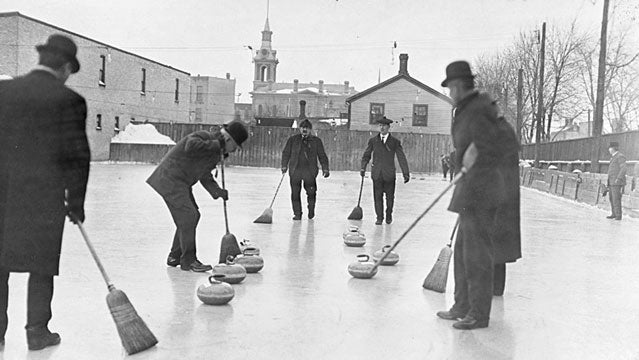In the late ’90s, there existed a man who went by the name of Merv Bodnarchuk. He looked pretty much exactly how you’d expect Merv Bodnarchuk to look: a well-kept, lip-tight mustache, some hair that’s more just on his head than there for any reason, wire-rimmed glasses, formless, hairy eyebrows, a chubby-but-mostly-featureless face that just happened to have a mouth and eyes because you need those things to see and to speak.
The Coldest Stone
Welcome to CurlingLife and Pants
The Worst Montage in Sports
The Best Curling Quiz in the World
“,” a 1999 profile of Bodnarchuk written by Guy Lawson, is probably the greatest piece of longform curling writing ever done. It might also be the only piece of longform curling writing ever done, but it stands up, by itself, as a really great piece of writing—curling or not.
As curling sits in that place of a small, concentrated number of passionate fans and a larger novelty/curiosity bump that comes every four years (but never lasts) from the Olympics, it can keep sitting in that place, and it might, which would be fine. Yet, as things change and time creeps forward and the world keeps spinning and etc., it could also move forward into a place of more permanent public consciousness, a place that generally brings along, at the very least, some more sustainable lifestyles tied to the sport. However realistic or utterly and completely unrealistic that thought is, Merv Bodnarchuk tried to make that happen.
Lawson’s piece tells the story of Merv’s grand desires: winning an Olympic gold medal for the United States, and to revolutionize curling into the next big, modern, money-making sport. And, at the beginning, as Merv tells Lawson his story over Coors Lights and clam juice—yeah, I just threw up, too—it sounds like a decent plan as all surface-level plans told extra-enthusiastically do. More Canadians watched curling on TV than any other non-hockey sport. And Merv knew curling because he was Canadian—except, unlike most Canadians, Merv was also an entrepreneur. So, he’d get his U.S. citizenship, create his team (the “Anaheim Earthquake”), pay all of the best curlers (like he was also doing in Canada) to be part of the Earthquake, make it huge in the U.S., and then win the gold in 2002 in Salt Lake City. After that? Anything—“Hell, Merv was going to create beach curling; the technology exists to make ice anywhere, he said”—was possible.
As you know—by virtue of you being alive, and therefore being someone who hasn’t heard of an American professional-curling circuit—none of this happened. Merv, it turns out and as the title says, had one requirement for his teams: he’d curl lead, which means he’d deliver the first two stones. Except, Merv was a terrible-to-maybe-decent-at-best professional curler, and, basically, no team with Merv curling on it could ever be a competitive Canadian/American team, let alone a gold medalist.
Yet, the story ends on an optimistic note, as Merv’s team wins a tournament and the $10,000 big-ass-check that comes with it. Throughout the story, Merv seems like and is one of those people whose ambitions are way bigger than his capabilities; he’s just yet to realize it. It’s sweet in that way—in the you-don’t-want-to-tell-him-that-none-of-this-is-ever-going-to-happen way—and sets up for a predictable series of stumbles and triumphs in a general narrative sense, with Merv settling in somewhere that is not quite curling overtaking soccer globally, but is still Merv achieving some kind of personal success that just doesn’t at all match up with his initial grand ambitions.
It turns out, though, that Merv’s moves might’ve been motivated by something more depressingly-sinister. —which leads “former professional curler and con man Mervin Bodnarchuk has always been a troublesome and contentious person”—is from 2007. It notes that Bodnarchuk had committed at least 50 securities offenses as of 1997 and that in July of 1999 he was arrested on 14 counts of theft. In 2005, he was convicted on all counts and sentenced to 18 months in custody, where “always demanding and complaining, he became one of the B.C. Corrections Branch’s most troublesome clients.”
The next—and last—time Bodnarchuk appears in the news-sphere (his Internet presence is minimal) is in connection with a touring hockey series of ex-NHL players. It’s not clear what Bodnarchuk’s role is here, but he’s some kind of promoter/coach—always involved on multiple levels. All the stories are negative ones. Most concern after they entered into a competitive senior series. (So hard, apparently, that he went as far as to file a police complaint and remove his team from the playoffs. “I wish that I could play them again and I was 25 years younger,” , 59 at the time.) The complaints, , were absolutely bogus, which is not at all surprising at this point.
And that is where Merv’s footprints stop: with his curling dreams presumably never fully formed, and who knows if those were really his dreams anyway, or just a way to make some money and get his name at the forefront of something, which seems way more likely when you look at what’s transpired since he last curled lead. But again, three years is a long time; a lot can happen, and surely did, from 2010 until now.
Whether he’s still trotting out retired NHLers or moved on to exploiting competitive youth trampolinists in Edmonton or selling squirrels-he-trained-to-be-butlers in Manitoba, Merv Bodnarchuk had a vision for a sport, and it wasn’t realistic and it probably wasn’t sincere, but it showed something. Wherever the sport goes—or stays—it’ll do it without Merv because there was enough—structure in place, people who cared and did this, enough curling—for it not to get sucked in by some batshit entrepreneur tipping himself for some bizarre curling-world dominance, but also, more than that, enough for him to even exist in the first place.


